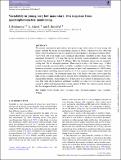Files in this item
Variability in young very low mass stars : two surprises from spectrophotometric monitoring
Item metadata
| dc.contributor.author | Bozhinova, Inna Nikolaeva | |
| dc.contributor.author | Scholz, Alexander | |
| dc.contributor.author | Eislöffel, J. | |
| dc.date.accessioned | 2016-04-11T14:00:09Z | |
| dc.date.available | 2016-04-11T14:00:09Z | |
| dc.date.issued | 2016-05-21 | |
| dc.identifier | 241842658 | |
| dc.identifier | 623dc622-e0a7-4a43-8c00-c65af44891ce | |
| dc.identifier | 84964735365 | |
| dc.identifier | 000375799000061 | |
| dc.identifier.citation | Bozhinova , I N , Scholz , A & Eislöffel , J 2016 , ' Variability in young very low mass stars : two surprises from spectrophotometric monitoring ' , Monthly Notices of the Royal Astronomical Society , vol. 458 , no. 3 , pp. 3118-3133 . https://doi.org/10.1093/mnras/stw455 | en |
| dc.identifier.issn | 0035-8711 | |
| dc.identifier.other | BibCode: 2016MNRAS.tmp..284B | |
| dc.identifier.other | ArXiv: http://arxiv.org/abs/1602.07925v1 | |
| dc.identifier.uri | https://hdl.handle.net/10023/8596 | |
| dc.description | The authors acknowledge support from the Science & Technology Facilities Council through grants no. ST/K502339/1 and ST/M001296/1. | en |
| dc.description.abstract | We present simultaneous photometric and spectroscopic observations of seven young and highly variable M dwarfs in star-forming regions in Orion, conducted in four observing nights with FOcal Reducer and low dispersion Spectrograph2 at European Southern Observatory/VLT. All seven targets show significant photometric variability in the I band, with amplitudes between 0.1–0.8 mag, The spectra, however, remain remarkably constant, with spectral type changes less than 0.5 subtypes. Thus, the brightness changes are not caused by veiling that ‘fills in’ absorption features. Three objects in the σ Ori cluster (age ∼3 Myr) exhibit strong Hα emission and Hα variability, in addition to the continuum variations. Their behaviour is mostly consistent with the presence of spots with temperature of ∼300 K above the photosphere and filling factors between 0.2–0.4, in contrast to typical hotspots observed in more massive stars. The remaining targets near ϵ Ori, likely to be older, show eclipse-like light curves, no significant Hα activity and are better represented by variable extinction due to circumstellar material. Interestingly, two of them show no evidence of infrared excess emission. Our study shows that high-amplitude variability in young very low mass stars can be caused by different phenomena than in more massive T Tauri stars and can persist when the disc has disappeared and accretion has ceased. | |
| dc.format.extent | 11819853 | |
| dc.language.iso | eng | |
| dc.relation.ispartof | Monthly Notices of the Royal Astronomical Society | en |
| dc.subject | Brown dwarfs | en |
| dc.subject | Stars: low-mass | en |
| dc.subject | Stars: pre-main-sequence | en |
| dc.subject | Stars: variables: T Tauri | en |
| dc.subject | QB Astronomy | en |
| dc.subject | QC Physics | en |
| dc.subject | NDAS | en |
| dc.subject.lcc | QB | en |
| dc.subject.lcc | QC | en |
| dc.title | Variability in young very low mass stars : two surprises from spectrophotometric monitoring | en |
| dc.type | Journal article | en |
| dc.contributor.sponsor | Science & Technology Facilities Council | en |
| dc.contributor.sponsor | Science & Technology Facilities Council | en |
| dc.contributor.sponsor | PPARC - Now STFC | en |
| dc.contributor.sponsor | Science & Technology Facilities Council | en |
| dc.contributor.institution | University of St Andrews. School of Physics and Astronomy | en |
| dc.identifier.doi | 10.1093/mnras/stw455 | |
| dc.description.status | Peer reviewed | en |
| dc.identifier.grantnumber | ST/M001296/1 | en |
| dc.identifier.grantnumber | ST/I000666/1 | en |
| dc.identifier.grantnumber | PP/D000890/1 | en |
| dc.identifier.grantnumber | ST/G001006/1 | en |
This item appears in the following Collection(s)
Items in the St Andrews Research Repository are protected by copyright, with all rights reserved, unless otherwise indicated.

